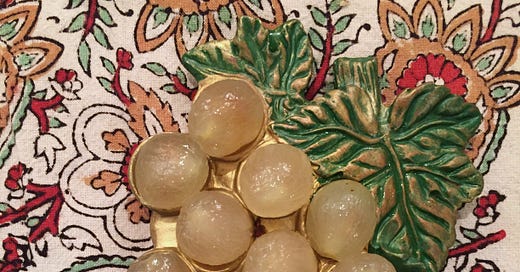Growing up, my New Year’s Day was always associated with existential dread. In my family (on my dad’s side, at least), it was said that if you wanted to have luck in the new year, you needed to choke down eat boiled cabbage and cornbread. I, picky eater that I was, had to face a paralyzing decision: do I reject the meal and face 365 days of bad luck, or do I go against all of my principles and instincts and eat some of the sulfuric brassica placed in front of me? Childhood Kiki settled on a compromise: I would pick at some of the cornbread, but there was no way that cabbage was getting anywhere near my mouth. Some luck was better than no luck, and truth be told I didn’t mind cornbread much at all, especially when slathered with butter.
Luckily for the children of Spain, good fortune is brought by tasty grapes instead of mushy cabbage. Here, Nochevieja (New Year’s Eve) is celebrated by eating twelve grapes at midnight: one grape at each chime of the bell tower in the Plaza del Sol (think Madrid’s answer to Times Square).
But why twelve grapes, and why grapes at all? The most popular theory is that one year in the early 1900s there was an exceptionally abundant harvest of grapes, and in order to sell more fruit the growers decided to rebrand the grapes as symbols of luck. They packaged them in groups of twelve and labeled them “uvas de la suerte” (lucky grapes)—one lucky grape for each of the twelve months of the coming year.
The above theory is the one that I’ve always heard, but in doing a bit more research, it seems like this is… not true. According to National Geographic Spain, newspapers were already talking about a revolt concerning these so-called lucky grapes in 1882. NGS explains that all of this uva business likely originated from the previously established upper-class tradition of eating grapes and drinking champagne on New Year’s Eve.
Un grupo de madrileños decidieron ironizar esta tradición acudiendo a la Puerta del Sol para comer uvas acompañados del sonido de las campanadas. Esta acción de revuelta por la distinción de clases de cara a la Navidad llevó a los chulapos a reunirse para comer uvas, como burla de la costumbre aristócrata.
(A group of people from Madrid decided to satirize this tradition by going to the Puerta del Sol to eat grapes alongside the sound of the chimes. This act of rebellion against the division of social classes at Christmas caused the working class to get together to eat grapes, to poke fun of the aristocratic tradition.)
As I mentioned last week, I love traditions and superstitions, so as soon as I heard about las uvas de la suerte, I was all in. In fact, on January 1, 2015, I sent this text to David:
That following New Year’s Eve, I actually participated in the tradition a distancia (from afar) by essentially playing the grapes version of Chubby Bunny at 5:00pm in the middle of my kitchen in Chicago. Of course, this time didn’t really count, since I wasn’t really in Spain, and it wasn’t really midnight in Chicago. I didn’t even worry much about my success (although for the curious, I did manage to eat all of them in time!).
But later in the year, after my move to Madrid was set, I decided that I needed to start training for the real deal. I was going to need to kick off my first full year in Spain with lots of luck, which meant I couldn’t arriesgarme a fallar (risk failing) during the grapes tradition. Luckily, I only needed one time trial (I practiced with a video from the previous year’s televised celebration in Madrid). With two successes under my belt, I felt confident that I could pass the test once on Spanish tierra (ground/land).
That first NYE in Madrid, I have to admit I was slightly worried about meeting the reto (challenge). Even so, I rejected David’s offer to peel the grapes for me (This is what parents usually do for little kids so that it’s easier for them to chew and swallow the fruit. They also remove the seeds if the grapes have them.). When the chimes started, muscle memory (okay, mostly adrenaline) kicked in, and I easily passed the test, locking in my luck for the coming year.

Not to jinx myself, but I’ve managed to eat the grapes in time every year so far (in reality, you have a little over 30 seconds to accomplish the task). It sounds easier than it actually is, especially when trying hard not to laugh when surrounded by people gnawing on grapes like their lives depended on it. Like most traditions here though, no one takes it super seriously, and it’s just a fun thing people do with their families before going out to celebrate with friends.
No disrespect to my family’s traditions, but eating grapes like a squirrel stuffing acorns for the winter is much more fun than a calm meal of cabbage. Maybe this year I’ll eat some cornbread as a nod to my own heritage. But it’ll have to be the next day, because eating twelve slices of cornbread under time pressure seems like a task best left to Joey Chestnut.
Feliz año!1 Wishing you a New Year filled with an abundance of luck, health, and happiness!
Ki
Feliz año: Happy New Year






Love it! Happy New Year!
I think it's hilarious that we both used the word existential in our last posts of the year.😂
Cheers to you and happy to have "met" you in 2022!